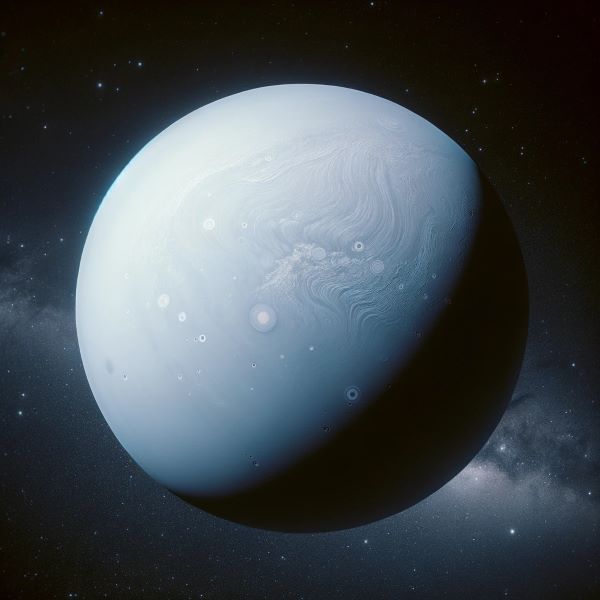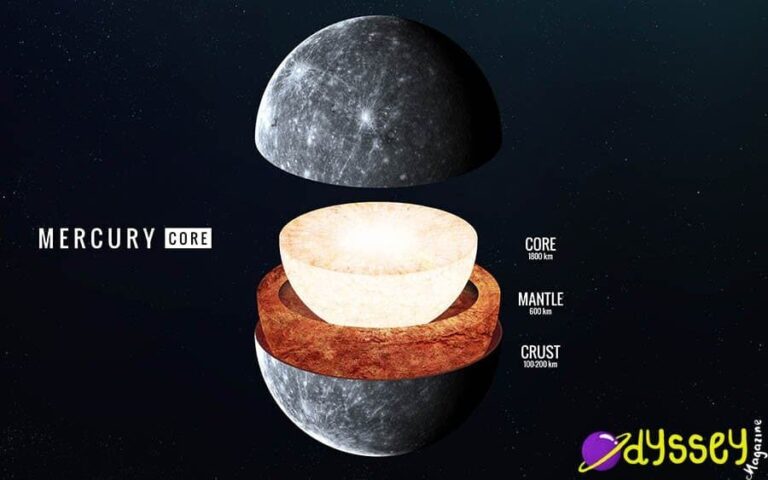What Is Uranus Made Of?
Have you ever wondered what the mysterious planet Uranus is made of? From its striking blue-green color to the swirling clouds that surround it, this distant world has captivated scientists and stargazers alike. Now, for the first time, we are uncovering some of Uranus’ deepest secrets – including what it’s composed of and how this composition affects its behavior in space. Join us on a journey as we explore what lies beneath the veil of one of our Solar System’s most enigmatic planets!
Uranus’ Composition

Uranus is the seventh planet from our sun and one of the four outer planets in our solar system. Being a gas giant, it is composed mostly of hydrogen and helium with traces of water, ammonia and methane. It has an average diameter of approximately 32,000 miles making it slightly smaller than Neptune but still four times larger than Earth.
Atmosphere
The atmosphere on Uranus consists mainly of molecular hydrogen (83%) and atomic helium (15%). This is surrounded by small amounts of other gases such as methane, ammonia, water vapour and carbon dioxide which give the planet its unique blue-green colour. The temperature at the top level where these gases are located is around -357°F (-216°C), while deeper down there could be temperatures up to 5400°F (3000°C). The pressure within this layer can reach up to 2000 atmospheres!
Interior
The interior structure starts with a rocky core made out of silicate rocks similar to what we find on Earth. Above that lies an icy mantle made out from different compounds like water ice and frozen ammonia – some believe that there might also be a liquid layer between them consisting mainly out from slushy ice particles suspended in liquid hydrocarbons such as ethane or methane. These layers are then topped off by a gaseous envelope made out from hydrogen, helium and other trace molecules mentioned earlier.
Magnetosphere
Uranus’ magnetosphere is quite peculiar; rather than having its magnetic field aligned along its rotational poles like all other planets do, Uranus’ field points 60 degrees away from both poles! This means that when looking at Uranus you would see two huge rings extending outward above each pole instead of just one big ring around it like most planets have – this peculiarity makes it stand apart! Additionally due to its slow rotation speed (17 hours per day) compared to Earth’s 24 hours per day – this results in weaker magnetism surrounding the planet which might explain why many spacecrafts struggle when trying to send back accurate data about Uranus’ environment or composition.
Chemical Make-up of Uranus
Uranus is an icy giant located in the outer reaches of our Solar System, and its chemical makeup has been a subject of debate for years. Its atmosphere contains large amounts of hydrogen and helium with traces of methane, water vapor, ammonia ice and other minor compounds. The majority of its mass comes from molecular hydrogen that makes up 83% by volume; other gases include 15% helium, 2% methane and trace amounts of nitrogen, oxygen and carbon monoxide.
The most interesting aspect about Uranus’s chemical make-up is that it differs greatly from the other planets in our Solar System – including Earth. It lacks the abundance of heavy elements such as iron or sulfur found on many other planets which points to one possible explanation: Uranus formed further away from the Sun than any other planet due to increased temperatures closer to the star.
- It lacks abundance of heavy elements
- Atmosphere contains large amounts hydrogen & helium
- Traces methane, water vapor & ammonia ice
These differences can be attributed to how much radiation heating each part receives during formation as well as complex processes like shock wave compression melting some materials while leaving others intact. This means that even though two planets may appear similar in size or composition their internal structure could still be drastically different due to how they were made billions years ago.
- Radiation heating affects each part differently
- Shock wave compression melts some materials but not others
- Internal structures are drastically different due to formation billions years ago.
Atmospheric Elements of Uranus
Uranus is a fascinating planet that holds many secrets. Its atmosphere is composed of several different elements, all of which contribute to its unique geology and climate. Let’s take a closer look at the atmospheric elements found on Uranus!
Hydrogen – The majority of Uranus’ atmosphere (around 80%) is made up of hydrogen gas, making it one of the most abundant elements in its air. This hydrogen gas helps create the planet’s deep-blue appearance from afar, due to its ability to absorb red light and reflect blue hues when exposed to sunlight. Hydrogen also plays an important role in controlling temperatures on Uranus, as it can help retain heat near the surface or allow cooler air from outer space into the atmosphere.
Helium – While not quite as abundant as hydrogen, helium does still make up a significant portion (15%) of Uranus’ atmosphere. Helium acts like an insulating blanket for the planet by trapping heat inside its layers and preventing much-needed energy from escaping outwards into space. Because it has no color or odor itself, helium serves mainly to enhance other gases within this layer such as methane and carbon dioxide while allowing them to remain at their necessary levels for life on this distant world.
Methane & Carbon Dioxide
These two gasses form only 4% combined volume but they are both very important components in helping maintain stable temperatures on Uranus throughout various seasons and timescales respectively.
- Methane makes up around 2% of this mix and gives off a bright blue hue which contributes significantly towards giving Uranus its iconic cobalt colouration.
- Carbon dioxide takes up only 2%, but has been proven essential for moderating temperatures so that seasonal variations don’t become too extreme across large parts of the globe.
Surface Composition & Structure of Uranus
Uranus is one of the most mysterious planets in our solar system, and its surface composition and structure are no exception. In 1986, when Voyager 2 flew past Uranus, we learned about its blue-green coloration as well as some details about the planet’s topography and cloud layers. But what lies beneath this cloudy veil has remained relatively unknown until recently.
The clouds of Uranus are composed mainly of hydrogen sulfide (H2S), a gas that is toxic to humans. This gas creates an atmosphere with a pressure greater than Earth’s at sea level but much lower than Jupiter’s or Saturn’s atmospheres. A few kilometers below these clouds are two distinct layers: an upper troposphere layer composed mostly of water vapor, ammonia ice crystals, and traces of hydrocarbons; and a lower stratosphere layer made up primarily of methane ice particles suspended in hydrogen and helium gases.
The interior structure of Uranus is divided into four main parts: a rocky core surrounded by an icy mantle made up mostly of water ice; liquid oceanic regions where temperatures can reach thousands of degrees Celsius; molecular hydrogen surrounding the entire planet; and finally, clouds which form near the outermost regions known as the thermosphere.
Along With these components making up its surface composition & structure, scientists have also hypothesized that there could be a solid inner core at the very center — though they still don’t know for sure whether it exists or not. However they do know that any such solid core would likely be surrounded by dense liquid consisting mainly o f ammonia–water mixtures according to recent data analysis from various space probes sent out over time to study Uranus more closely..
Mantle & Core Materials of Uranus
Uranus’ Mantle
Uranus is the seventh planet from our Sun, and it has a unique composition compared to its neighboring planets. Its mantle is composed of ice, water, methane and ammonia ices – the same materials that make up its core. The material in Uranus’ mantle is extremely cold due to the depth of which it lies within the planet’s atmosphere; temperatures reach as low as minus 216 degrees Celsius! This extreme cold means that these elements are not able to move around freely like other planets’ mantles can. Instead they form an icy crust which helps keep Uranus together structurally – without this layer, Uranus would be torn apart by powerful gravity forces outside of our Solar System.
The mantle itself consists primarily of gas molecules such as nitrogen (N2) and carbon dioxide (CO2), though there are smaller concentrations of heavier elements including sulfur (S). These gases help give Uranus its characteristic blue coloration and also provide insulation against heat loss from deep within the planet’s interior. Plus, some scientists believe that this frozen mix may contain organic compounds or even complex hydrocarbons which could potentially contribute to life on other worlds in our Solar System if conditions were right for them to exist there!
Uranus’ Core
The core at the center of Uranus is made up mostly of iron-rich silicates mixed with ice crystals and clathrate hydrates – basically cages filled with methane molecules trapped inside larger water molecules. This combination makes up about 15 percent of Uranum’s mass but only occupies a small fractional volume because so much pressure exists at those depths below its surface layers. It’s estimated that temperatures in uranium’s core range anywhere between 2200 Kelvin (1900°C) near its outer edge all the way down 6000 Kelvin (5700°C) closer towards its center – significantly hotter than any temperature found on Earth! All this energy released from radioactive decay within uranium’s core provides enough power for magnetic fields similar to ones seen on Jupiter & Saturn but weaker due their more distant position away from our star system’s sun.Magnetic Field Characteristics of Uranus
Uranus is the seventh planet from the sun and has a unique magnetic field compared to other planets in our solar system. This type of magnetism, also known as an induced magnetosphere, occurs when particles generated by the planet’s interior interact with its atmosphere. The result is a highly complex and dynamic magnetic field that behaves differently than most others in our solar system.
The main characteristics of Uranus’ magnetic field are its strength, direction, orientation and shape. Its strength is much weaker than that of Earth’s; however, it still has enough power to protect any life forms on Uranus from radiation from deep space. It has been estimated that its total intensity ranges between 10-15 Gauss near the equator to 1-4 Gauss at higher latitudes – about one-tenth as strong as Earth’s magnetic field at any given point on its surface.
Uranus’ magnetic poles are not aligned with those of its rotational axis like all other planets except Venus – they are actually shifted 60° away from them! This means that when looking down upon Uranus’ north pole (the south pole would be below us), we would observe a combination of positive and negative fields instead of just one or the other like most other planets have. Along With this unusual directional alignment, Uranus’ magnetosphere also appears far more elongated than those of other planets due to variations in plasma density around it which create ‘magnetic bubbles’ stretching out into space for hundreds or thousands kilometers beyond where one might expect them normally stop based on their mass alone
Gravitational and Rotation Dynamics of Uranus
Uranus is one of the most fascinating planets in our solar system. It has a unique set of dynamics that have made it an intriguing subject for astronomers and astrophysicists alike. When we look at Uranus, two of the most obvious characteristics are its rotation and gravitational pull. Let us take a closer look into how these two factors affect this gas giant planet.
Gravitational Dynamics
At 1.35 x 10^17 kg, Uranus is slightly less massive than Neptune but still more massive than all other planets in our solar system combined. This mass gives it immense gravitational power, which can be felt from far beyond its own orbit around the Sun and even by objects orbiting near Saturn’s orbit. The gravity of Uranus plays a major role in keeping asteroids away from other parts of our solar system as well as acting as an anchor point to keep moons and rings stable around it.Rotation Dynamics
When looking at pictures taken by spacecrafts like Voyager 2 or Hubble telescope, you may notice something strange about Uranus – it appears to be tipped on its side! That’s because unlike any other planet in our Solar System , this gas giant rotates along its axis almost perpendicular to the plane formed by all 8 planets orbiting the Sun . This tilt means that during certain times of year half of this planet will face towards or away from Earth making certain regions much colder or warmer compared to others depending on what time you observe them .The combination between these two forces creates interesting patterns on both large scales (the whole shape and size) and small ones (weather patterns). While many aspects are still being studied thoroughly such as why does Uranus rotate sideways so differently compared to every other planet? We do know enough about these two forces when combined together make up some very unique features found only within this icy blue world!
Impact of Composition on Uranian Behavior
Uranians are known for their unique behavior, but have you ever stopped to consider the impact of composition on it?
Composition plays a major role in determining Uranian behavior. The elements that make up Uranus’s atmosphere, its core composition and the gravitational forces at play all affect how Uranians interact with each other.
First and foremost, the atmospheric composition of Uranus has been found to influence how its inhabitants behave. Its thick layer of hydrogen and helium gas traps heat from the sun within it’s atmosphere which creates large temperature differences between day and night cycles. This can lead to mood swings among Uranian citizens as they adapt themselves around this fluctuating environment.. On top of that, many studies suggest that certain chemical compounds present in the air such as methane may be responsible for heightened levels of aggression amongst Uranians during times when temperatures rise rapidly.
Secondly, evidence suggests that gravity affects how members of society interact with each other on an individual level whilst also having wider implications across entire communities. Being located so far away from Earth means that those born on the planet experience higher levels of gravitational force than us here on Earth do – this can lead to physical changes such as elongated limbs or even altered brain development which could contribute towards more creative thought processes or seemingly erratic behavior patterns. Along With this, research shows that high-gravity environments tend to promote cooperation between individuals due to increased difficulty experienced when performing tasks alone compared with working together – this is beneficial for creating strong communal bonds amongst people living there!
Finally, we must take into account what lies beneath: the core composition of Uranus is incredibly dense given its size – primarily made up iron/nickel heavy materials like silicates & carbonates along side lighter elements like water ice & ammonia hydrates – causing significant pressure upon any life forms living on its surface above ground level.. Studies have shown correlations between these pressures being applied onto inhabitants directly impacting their thought process & resulting behaviors (eg: feeling ‘trapped’ leading towards higher anxiety levels). It is therefore essential that any visitors understand these conditions before traveling there in order better prepare themselves prior arrival!
To sum it up, it is clear that both external factors such as atmospheric composition combined with intrinsic characteristics like gravity have a considerable impact upon how people live & behave within society on Uranus – understanding them will help anyone visiting gain greater insight into local customs & culture so much easier whilst travelling there!

